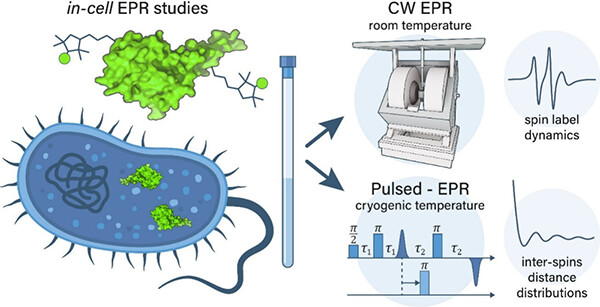La RPE « in-cell » (SDSL-EPR) révolutionne l’étude des protéines en révélant leur dynamique et interactions dans leur environnement naturel! Découvrez comment cette technique prometteuse évolue et ce qu’elle réserve pour l’avenir.
La recherche sur l’impact du milieu intracellulaire sur la structure et les interactions des protéines est essentielle pour comprendre les biomolécules dans leur environnement naturel. Reproduire cet environnement en dehors des cellules est complexe, d’où l’importance croissante de l’étude directe des biomolécules in situ. La spectroscopie
par résonance paramagnétique électronique (RPE) associée au marquage de spin dirigé (SDSL-EPR) s’est révélée un outil puissant pour analyser ces biomolécules dans les cellules. Depuis le premier test RPE « in-cell » en 2010, cette technique a beaucoup évolué. Cette revue présente les développements récents, les méthodes de préparation des échantillons, les marqueurs de spin disponibles, et comment la RPE « in-cell » est appliquée à différents systèmes biologiques, tout en examinant l’impact de l’environnement cellulaire sur les protéines. Elle explore aussi les futures avancées prévues pour cette technique prometteuse.
In-cell EPR (SDSL-EPR) is revolutionizing the study of proteins by revealing their dynamics and interactions in their natural environment! Discover how this promising technique is evolving and what it holds for the future.
The study of the impact of the intracellular environment on protein structure and interactions is essential for understanding biomolecules in their natural environment. Reproducing this environment outside the cell is complex, hence the growing importance of studying biomolecules
directly in situ. Site-directed spin labeling coupled to electron paramagnetic resonance spectroscopy (SDSL-EPR) has proved a powerful tool for analyzing these biomolecules in cells. Since the first in-cell EPR test in 2010, this technique has evolved considerably. This review presents recent developments, sample preparation methods, available spin markers, and how in-cell EPR is applied to different biological systems, while examining the impact of the cellular environment on proteins. It also explores future advances planned for this promising technique.




